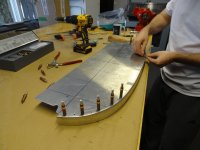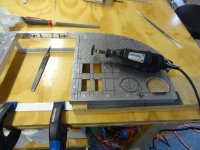Buzzcola777
MEMBER
Montreal, Canada
Electrical / Avionic and the like...Part 1
The dreaded electrical system!!!
I never could understand electricity, I just don’t know why but it always been like this. For some guys it is just natural but for me it is a nightmare. Volts, Amps, Ohms are not the guys I used to hang around with. So in order to educate myself I started by reading ‘’The Aero Electric Connections’’ by Bob Nuckolls. Very well written with lots of explanatory diagrams, exactly what I needed! Also a bunch of articles about basic electrical written by Ron Alexander, all very instructive for a beginner like myself. So to make a long story short here are some pointers given by Ron before starting cutting wires:
So in order to begin this section of the project I needed to determine what I wanted for instruments. Having flown on machines that only had primary flight display (PFD) and multi-function display (MFD) as reference, I decided to go that route, so no steam gauges.
Here is the list of equipment that will be installed in this aircraft:
NOW, this is where I will need you guys to point me in the right direction because it is not my field of expertise!!
Here is my attempted schematic of the system:

12 Volts system with:
Also according to the wire size chart I made a list of the circuit protection requirements for all the equipment planned for this project.



So, once again Gents, if you have a chance, please review this and just go ahead with your suggestions / comments.
More to follow!
Dan
The dreaded electrical system!!!
I never could understand electricity, I just don’t know why but it always been like this. For some guys it is just natural but for me it is a nightmare. Volts, Amps, Ohms are not the guys I used to hang around with. So in order to educate myself I started by reading ‘’The Aero Electric Connections’’ by Bob Nuckolls. Very well written with lots of explanatory diagrams, exactly what I needed! Also a bunch of articles about basic electrical written by Ron Alexander, all very instructive for a beginner like myself. So to make a long story short here are some pointers given by Ron before starting cutting wires:
- Determine what electrical equipment you want to install
- Locate these components within the aircraft structure
- Locate your battery, bus bars, and circuit breaker panels
- Protect the components by determining proper wire size and circuit breaker/fuse requirements
- Connect component parts to an adequate power source
- Ground and bond necessary items
- Install proper instrumentation to monitor the system
- Draw a detailed schematic of the system for reference
So in order to begin this section of the project I needed to determine what I wanted for instruments. Having flown on machines that only had primary flight display (PFD) and multi-function display (MFD) as reference, I decided to go that route, so no steam gauges.
Here is the list of equipment that will be installed in this aircraft:
- ILEVEL 3AW: It provides ADS-B Weather & traffic information, GPS navigation, AHRS and DATA Recording. It is portable and WI-FI
- GRT - Engine Information System / Model 4000: Displays all information needed for the engine and more. Also this EIS is wired to the ILEVEL and connect to the IPAD
- IPAD PRO 10.5 inch for AHRS and NAV
- IPHONE for EIS display information
- KT-6A Transponder
- KY-97A COMMS
- PM1200 Intercom
- BLUE SEA Systems for distribution Bus
- EARTH X – ETX 680C Battery
- Plane Power 70 Amp Alternator…This alternator came with the engine that I bought. I’ll be able to hang Christmas lights all over the aircraft for night flying.
NOW, this is where I will need you guys to point me in the right direction because it is not my field of expertise!!
Here is my attempted schematic of the system:

12 Volts system with:
- LAMAR 12 VOLT CONTINOUS DUTY
- LAMAR 12 VOLT INTERMITTENT DUTY
- CESSNA Type split rocker master switch
- ACS A-510-2 Ignition switch
Also according to the wire size chart I made a list of the circuit protection requirements for all the equipment planned for this project.



So, once again Gents, if you have a chance, please review this and just go ahead with your suggestions / comments.
More to follow!
Dan










































































 !!!
!!!